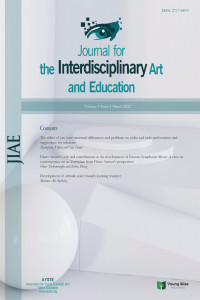Dali and the piano: the symbolic significance of the piano as instrument in the works of Salvador Dali
Dali and the piano: the symbolic significance of the piano as instrument in the works of Salvador Dali
salvador dali, dali, piano, art, surrealism, paintings, symbols, symbols in Dali's paintings, piano image piano in art,
___
- Aronskaya, Y. (2022). 20th century through the eyes of a genius. Retrieved 2 February 2022, from http://www.dali-genius.ru/surrealism-principle.html
- Balandin, R. (2010). Salvador Dali. Moscow. Veche.
- Benua, S. (2014). Gala. How to make a genius out of Salvador Dali. Retrieved 12 February 2022, from https://litresp.ru/chitat/ru/%D0%91/benua-sofjya/gala-kak-sdelatj-geniya-iz-saljvadora-dali/31
- Dali, S. (1996). The Secret Life of Salvador Dali, written by himself. About myself and about everything else. Kyiv. Svarog.
- Dali, S. (2005). Surrealism is me. Moscow. Vagrius
- Dali, S. (2020). My Secret Life. Minsk. Potpourri.
- Domarackaya, E. (2002). Andre Breton and the formation of the poetics of French surrealism in the 20s - early 30s of the XX century. St. Petersburg. Skifia-Print.
- Freud, S. (2007). Introduction to Psychoanalysis. St. Petersburg. Peter.
- Kotovsky, V. (2008). Dangerous to meet on the stone plateau. Retrieved 12 February 2022, from https://stihi.ru/2008/11/16/2964
- Ospovat, L. (1965). Garcia Lorca. Moscow. Molodaya Gvardiya.
- Ostanina, S. (2002). Encyclopedia of Still Life. Moscow. Olma-Press.
- Petryakov, A. (2008). Salvador Dali. Divine and many-sided. St. Petersburg. Piter.
- Sasina, Y. (2022). Dali symbols. What is behind them. Retrieved 5 February 2022, from https://arthive.com/publications/299~Dali_symbols_What_is_behind_them?_lang=EN
- Timofeev, V. (2019). Methods of searching for Slavic roots in foreign words. Retrieved 9 March, from http://www.tezan.ru/metod.htm
- Torroella, R. S. (1998). Los Putrefactos de Dali y Lorca. Spain. Tarahumara.
- Photos Web sites Web 1. https://www.salvador-dali.org/en/artwork/catalogue-raisonne-paintings/obra/307/the-mysterious- sources-of-harmony
- Web 2. https://archive.thedali.org/mwebcgi/mweb.exe?request=record;id=3993;type=101
- Web 3. https://www.wikiart.org/en/salvador-dali/partial-hallucination-six-apparitions-of-lenin-on-a-piano-1931
- Web 4. https://www.salvador-dali.org/media/upload/cataleg_pintura/MITJA/0385.jpg
- Yayın Aralığı: Yılda 4 Sayı
- Başlangıç: 2020
- Yayıncı: Genç Bilge Yayıncılık
Examination of the progressive aspects of the piano etude genre of Russian composers
A new model for the teaching violin to young learners
A study on developing the evaluation scale of the polyphonic choir curriculum
Gülay LAÇİN, İlknur ÖZAL GÖNCÜ
Comparison of right-hand playing techniques used in flamenco guitar and baglama
